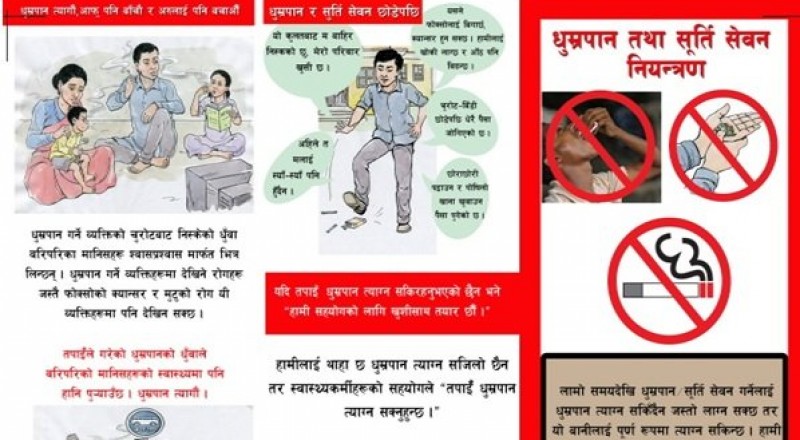Tobacco is one of the most preventable causes of illness and death. In addition to the direct effects on individual’s health, it leads to high health care cost for the individuals as well as the health system.
Tobacco in Nepal
Like many other countries, tobacco use is a major public health problem in Nepal. Though 52% male and 13.3% female use tobacco products (NDHS 2011), the prevalence of tobacco use has been declining over the years with prevalence being 53.4% among men and 19.6% among women aged 15-49 in 2006. The overall prevalence has also reduced to 28.5% in 2006 to 22.8% in 2011. Among various form of tobacco use, cigarette smoking is the most common. However, use of smokeless tobacco is also on the rise and different forms of smokeless tobacco such as khaini, zarda, gutkha, pan masala, gul, snuff and others.
Youth have been major users of tobacco and second hand smoking. Various surveys conducted reveal a high percentage of tobacco users among youth and health professional students. Nearly 5 in 10 school students are exposed to second-hand smoke in public places and the tobacco industry continues to target the youth through widespread advertisement, promotion and sponsorship.
Tobacco Control – From Policy to Practice
Nepal became a Party to the WHO Framework Convention on Tobacco Control on February 5, 2007. The Tobacco Product (Control and Regulation) Act, 2010 is the primary law governing tobacco control in Nepal. This act requires products to be licensed and companies selling tobacco to be registered; ban on the sale of smokeless tobacco to under-18 age group, ban on tobacco consumption in all public and work places and prohibits advertising. Pictorial health warnings were implemented in April 2014. The government has issued a directive increasing the size of the pack warnings to 90 percent of the front and back of all tobacco products packaging. Similarly, MPOWER policy package of WHO has been taken as a roadmap for tobacco control activities in Nepal. Policy formulation, advocacy, awareness with behaviour change and training activities have been conducted by the Nepal National Health Education, Information and Communication Centre (NHEICC), which is the national focal point for tobacco control under the Ministry of Health and Population.

Implementation Issues
Although tobacco control legislation and policies exist in Nepal, they have been found to be either inadequate or poorly implemented. Reasons for this include a lack of training of law enforcers; unclear roles within government departments; and inadequate resources for enforcement. Furthermore, illicit trade between India and neighbouring countries, and sale in informal establishments, often in unpackaged forms are other challenges. For smokeless tobacco, in addition to above, there is inadequate data on the production and distribution of smokeless tobacco products, making it difficult for policy makers to develop, implement and enforce effective control measures for these products.
The Road Ahead
Where effective implementation of the existing policies are essential to reduce tobacco use and initiation among youth and adults, it is absolutely vital to establish new policies to reduce exposure to second hand smoke especially for the youth. Multi-sectoral efforts are needed forstrengthening the enforcement mechanism on smoke-free policies.
HERD’s Efforts towards Tobacco Control
Developing a Behaviour Change Intervention for Smoking Cessation within primary care in Nepal
Preventing tobacco use and helping tobacco users to quit is beneficial for individuals as well as the health system of any country. HERD collaborated with National Tuberculosis Centre (NTC) and NHEICC to conduct a 2 year study to assess the feasibility of a behaviour change intervention within the Practical Approach to Lung Health (PAL) programme in 2 districts of Nepal: Kathmandu and Rupandehi. Through this COMDIS-HSD project (research programme consortium operating under UKAID), all the patients in the selected primary health care centres with respiratory problems who smoked were given the counselling support by health workers to help them quit smoking. During the counselling sessions, health workers employed behaviour change techniques, addressing factors such as maintaining will power and motivation to give up smoking. Information Education and Communication (IEC) materials such as flip books and leaflets were also used during the study. 37% quit rate was seen among smokers who received the intervention. The study also demonstrated that embedding smoking cessation within routine primary care is key to successful delivery with a need of effective reporting and supervision mechanisms within the health system.

WHO Sri Lanka team in our intervention site, Primary Health Care Centre in Kathmandu during their observation visit on effectiveness of smoking cessation in Nepal
The then NTC Director Dr. Rajendra Pant during Intervention Review Workshop
Supply Chain of Smokeless Tobacco in Nepal: A Feasibility Study
HERD conducted a feasibility study in 2013 to assess the feasibility of conducting a multi-country study of the production and supply chain of smokeless tobacco in South Asia. Overall, the study was successful in identifying and interviewing actors involved in the supply chain of Smokeless Tobacco (SLT), providing relevant information such as including identification of the best recruitment methods to use and how the data collection tools can be refined. A larger study using the tools and learning from this could provide important evidence for policy makers to enable them to effectively regulate SLT products.
Contributors: Dr Sushil Baral, Sudeepa Khanal and Sudeep Uprety




Comments(0)
No comments found.